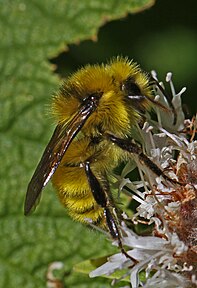Wikipedia:Wikipedia Signpost/2024-02-13/Gallery
Before and After: Why you don't need to touch grass to dramatically improve images of flora and fauna
Inspired by Adam Cuerden's recent article on finding and improving photos for biographies, I wanted to write a quick guide to finding and improving images for biology using a tool called Wiki Loves iNaturalist. It has a lot of nice functionality that I encourage you to play with, but before we get to a mini-tutorial, let's do a round of before and after photos so you can see what it offers.
Yay, makeovers! Or at least a change from pinned insects to live specimens. All the updated photos came from iNaturalist, a platform that allows scientists to track ecosystems in real-time through crowdsourcing. Because iNaturalist allows users to release their observations under Creative Commons licenses (if they choose), it can be a great resource for finding biology photos for Wikipedia.
As an example for this tutorial, let's find a good photo on iNat to illustrate Bombus pauloensis, the Paulista bumblebee, which has lots of enwiki article text but not one image! Fair warning: I'm a mobile-only user, so this mini-tutorial is screenshots via iPhone. I trust that after you become a WikiLovesiNat addict you will create a much prettier tutorial.
1. Find the iNaturalist observations page for your creature.
The Paulista bumblebee has 2,026 observations on iNaturalist, so the chances are good we can find something that suits!
2. Refine your search using the filters tool in the top right.
The most important filter is photo licensing. We can use CC0, CC-BY, and CC-BY-SA on Wikipedia. My default selection is CC-BY, since for whatever reason that one always yields me the most results. I also usually tick the box for research-grade observation, which means that at least two users agree on the identification to either species or genus, and that there are no ongoing disagreements about the ID.
3. Go image shopping.
This is where you get to make fun choices. You're now a photo editor who commands a global army of nature photographers working to bring you the world's most beautiful photos of bugs (or snakes or wildflowers or whatever). You can pick something bold that will look great on a thumbnail, or a dignified three-quarters-profile portrait, or something where the creature makes eye contact with the camera (to remind the reader that we are all part of a delicate web of life and even the smallest among us have value).
4. Find the observation ID of your selection.
Once you find something you like, click on the observation and snag the observation ID out of the URL, in this case number 102719185 from the URL https://www.inaturalist.org/observations/102719185 (Note that there are two distinct ID numbers involved with iNaturalist photos, the taxon ID and the individual observation ID. The individual observation ID is usually a 9 or 10 or 11 digit number, while the taxon ID is usually a 5 or 6 or 7 digit number.) Number in hand, make your way to the WikiLovesiNat site at https://wikilovesinat.netlify.app and:
5. Use WikiLovesiNat to effortlessly transfer the photo and key metadata from iNaturalist to Wikimedia Commons.
There's lots to play with on WikiLovesiNaturalist, but for the mission we're on today, we want to use the option labeled "Find an article using iNaturalist observation id". Enter the ID, verify that's your selection, click 'Upload to Commons', click submit again on Commons, and then as a mercy to us all, make sure to add a species category on that page, since that is not automated.
6. Add photo to article.
Congratulations. You now have fancy photos of your creature ready for use on the encyclopedia! You know the drill from here, but consider including the date and location of the observation in your image caption. (It's like citations but for real-world sightings.) You will also come to love observers who include little notes documenting what flower the bee was on, or what the weather was like when that mushroom popped up.
Finally, if you're already an iNaturalist user and want to release all your images under a CC license, adjust your iNaturalist preferences at Account settings > Content & Display > Licensing on the browser version of iNaturalist. You'd think as a dual user of Wikipedia and iNaturalist you'd have already uploaded anything valuable to Commons, but it's stuff like your inquiry into those aphids or lichens or that local species of spider (the one that you take for granted!) that will end up being clutch for some other editor.
Have fun exploring!





















Discuss this story
This is really exciting. I had no idea the tool existed! Joyous! Noise! 17:19, 13 February 2024 (UTC)[reply]
@Jengod:, an additional step after adding an image should be to check the talk page and remove anything that puts the article into a requested image category. There might be a {{photo requested}} template, but more frequently (at least for organisms) there is a
|needs-image=in a WikiProject banner. Talk:Bombus pauloensis is still marked as needing an image via the WikiProject Insects banner. The requested images categories aren't very useful because many articles that lack images were never added to them, but it doesn't help things to have articles that now have images remaining in the requested image categories. Plantdrew (talk) 20:32, 13 February 2024 (UTC)[reply]Great article, super cool! Frostly (talk) 02:39, 15 February 2024 (UTC)[reply]